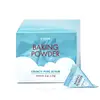What's inside
What's inside
 Key Ingredients
Key Ingredients

 Benefits
Benefits

 Concerns
Concerns

 Ingredients Side-by-side
Ingredients Side-by-side

Water
Skin ConditioningButylene Glycol
HumectantGlycerin
HumectantPEG-75
HumectantPEG/PPG-17/6 Copolymer
SolventAlcohol
AntimicrobialHydrolyzed Collagen
EmollientXanthan Gum
Emulsifying1,2-Hexanediol
Skin ConditioningPEG-60 Hydrogenated Castor Oil
EmulsifyingGlyceryl Caprylate
EmollientCentella Asiatica Extract
CleansingCarbomer
Emulsion StabilisingEthylhexylglycerin
Skin ConditioningPaeonia Suffruticosa Root Extract
Skin ProtectingChamomilla Recutita Flower Extract
MaskingDisodium EDTA
Potassium Hydroxide
BufferingParfum
MaskingSodium Hyaluronate
HumectantTocopherol
AntioxidantRetinol
Skin ConditioningPolysorbate 20
EmulsifyingCamellia Sinensis Leaf Extract
AntimicrobialWater, Butylene Glycol, Glycerin, PEG-75, PEG/PPG-17/6 Copolymer, Alcohol, Hydrolyzed Collagen, Xanthan Gum, 1,2-Hexanediol, PEG-60 Hydrogenated Castor Oil, Glyceryl Caprylate, Centella Asiatica Extract, Carbomer, Ethylhexylglycerin, Paeonia Suffruticosa Root Extract, Chamomilla Recutita Flower Extract, Disodium EDTA, Potassium Hydroxide, Parfum, Sodium Hyaluronate, Tocopherol, Retinol, Polysorbate 20, Camellia Sinensis Leaf Extract
Sodium Bicarbonate
AbrasiveWater
Skin ConditioningGlycerin
HumectantSilica
AbrasiveHydrated Silica
AbrasiveMicrocrystalline Cellulose
AbsorbentPEG-7 Glyceryl Cocoate
EmulsifyingPEG-60 Hydrogenated Castor Oil
EmulsifyingSodium Methyl Cocoyl Taurate
CleansingParfum
MaskingCellulose Gum
Emulsion StabilisingSodium Sulfite
PreservativeMenthoxypropanediol
MaskingLimonene
PerfumingHexyl Cinnamal
PerfumingSodium Chloride
MaskingDisodium EDTA
Linalool
PerfumingTetrasodium EDTA
Sodium Bicarbonate, Water, Glycerin, Silica, Hydrated Silica, Microcrystalline Cellulose, PEG-7 Glyceryl Cocoate, PEG-60 Hydrogenated Castor Oil, Sodium Methyl Cocoyl Taurate, Parfum, Cellulose Gum, Sodium Sulfite, Menthoxypropanediol, Limonene, Hexyl Cinnamal, Sodium Chloride, Disodium EDTA, Linalool, Tetrasodium EDTA
Ingredients Explained
These ingredients are found in both products.
Ingredients higher up in an ingredient list are typically present in a larger amount.
Disodium EDTA plays a role in making products more stable by aiding other preservatives.
It is a chelating agent, meaning it neutralizes metal ions that may be found in a product.
Disodium EDTA is a salt of edetic acid and is found to be safe in cosmetic ingredients.
Learn more about Disodium EDTAGlycerin is already naturally found in your skin. It helps moisturize and protect your skin.
A study from 2016 found glycerin to be more effective as a humectant than AHAs and hyaluronic acid.
As a humectant, it helps the skin stay hydrated by pulling moisture to your skin. The low molecular weight of glycerin allows it to pull moisture into the deeper layers of your skin.
Hydrated skin improves your skin barrier; Your skin barrier helps protect against irritants and bacteria.
Glycerin has also been found to have antimicrobial and antiviral properties. Due to these properties, glycerin is often used in wound and burn treatments.
In cosmetics, glycerin is usually derived from plants such as soybean or palm. However, it can also be sourced from animals, such as tallow or animal fat.
This ingredient is organic, colorless, odorless, and non-toxic.
Glycerin is the name for this ingredient in American English. British English uses Glycerol/Glycerine.
Learn more about GlycerinParfum is a catch-all term for an ingredient or more that is used to give a scent to products.
Also called "fragrance", this ingredient can be a blend of hundreds of chemicals or plant oils. This means every product with "fragrance" or "parfum" in the ingredients list is a different mixture.
For instance, Habanolide is a proprietary trade name for a specific aroma chemical. When used as a fragrance ingredient in cosmetics, most aroma chemicals fall under the broad labeling category of “FRAGRANCE” or “PARFUM” according to EU and US regulations.
The term 'parfum' or 'fragrance' is not regulated in many countries. In many cases, it is up to the brand to define this term.
For instance, many brands choose to label themselves as "fragrance-free" because they are not using synthetic fragrances. However, their products may still contain ingredients such as essential oils that are considered a fragrance by INCI standards.
One example is Calendula flower extract. Calendula is an essential oil that still imparts a scent or 'fragrance'.
Depending on the blend, the ingredients in the mixture can cause allergies and sensitivities on the skin. Some ingredients that are known EU allergens include linalool and citronellol.
Parfum can also be used to mask or cover an unpleasant scent.
The bottom line is: not all fragrances/parfum/ingredients are created equally. If you are worried about fragrances, we recommend taking a closer look at an ingredient. And of course, we always recommend speaking with a professional.
Learn more about ParfumPeg-60 Hydrogenated Castor Oil comes from hydrogenated castor oil. It is a solubilizer and emulsifier.
As a solubilizer, it helps dissolve ingredients into a water-based version. It is also an emulsifer. Emulsifier help prevent oils and water from separating. Both these properties help create evenly-spread and uniform products.
Basically, Peg-60 Hydrogenated Castor Oil helps hold ingredients together.
Learn more about PEG-60 Hydrogenated Castor OilWater. It's the most common cosmetic ingredient of all. You'll usually see it at the top of ingredient lists, meaning that it makes up the largest part of the product.
So why is it so popular? Water most often acts as a solvent - this means that it helps dissolve other ingredients into the formulation.
You'll also recognize water as that liquid we all need to stay alive. If you see this, drink a glass of water. Stay hydrated!
Learn more about Water